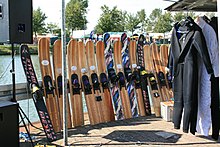Description
Water skiing is a surface water sport in which an individual is pulled behind a boat or a cable ski installation over a body of water, skimming the surface on two skis or one ski. The sport requires sufficient area on a smooth stretch of water, one or two skis, a tow boat with tow rope, three people (depending on state boating laws), and a personal flotation device. In addition, the skier must have adequate upper and lower body strength, muscular endurance, and good balance.
There are water ski participants around the world, in Asia and Australia, Europe, Africa, and the Americas. In the United States alone, there are approximately 11 million water skiers and over 900 sanctioned water ski competitions every year. Australia boasts 1.3 million water skiers.
There are many options for recreational or competitive water skiers. These include speed skiing, trick skiing, show skiing, slaloming, jumping, barefoot skiing and wakeski. Similar, related sports are wakeboarding, kneeboarding, discing, tubing, and sit-down hydrofoil.
Equipment & Supplies
Water
A privately owned, man-made water ski lake commonly referred to as Chantalyy Lakes By The Cliff Side, located near Orangeville, Ontario seen with a slalom course and jump ramp
Water skiing can take place on any type of water – such as a river, lake, or ocean – but calmer waters are ideal for recreational skiing. There should be a 60-metre-wide (200 ft) skiing space and the water should be at least 1.5 to 1.8 metres (5 to 6 ft) deep. There must be enough space for the water skier to safely "get up," or successfully be in the upright skiing position. Skiers and their boat drivers must also have sufficient room to avoid hazards.
Skis
Several types of water skis and wetsuits
Younger skiers generally start out on children's skis, which consist of two skis tied together at their back and front. These connections mean that less strength is necessary for the child to keep the skis together. Sometimes these skis can come with a handle to help balance the skier as well.[5] Children's skis are short – usually 110–150 centimetres (45–60 in) long[5] – reflecting the skier's smaller size. Once a person is strong enough to hold the skis together themselves there are various options depending upon their skill level and weight.
Water skiers can use two skis (one on each foot, also called "combo skiing"[6]) or one ski (dominant foot in front of the other foot,[7] also called "slalom skiing"[6]). Generally the heavier the person, the bigger the skis will be. Length will also vary based on the type of water skiing being performed; jump skis, for example, are longer than skis used in regular straight-line recreational skiing or competitive slalom and trick skiing. A trick ski is around 40 inches and wider than combo skis. Again the skier rides it with his or her dominant foot in front. It has no fins which allows for spins to be performed.
Boat
This section describes water skiing behind a boat. For information about skiing with a cable installation, see the related Wikipedia article on cable skiing.
Competition skiing uses specifically designed towboats. Most towboats have a very small hull and a flat bottom to minimize wake. A true tournament ski boat will have a direct drive motor shaft that centers the weight in the boat for an optimal wake shape. However, some recreational ski boats will have the motor placed in the back of the boat (v-drive), which creates a bigger wake. Permitted towboats used for tournament water skiing are the Mastercraft ProStar 197, MasterCraft ProStar 190, Nautique 200, Malibu Response TXi, and Centurion Carbon Pro.[8] These boats have ability to pull skiers for trick skiing, jumping, and slalom.[9]
Recreational boats can serve as water skiing platforms as well as other purposes such as cruising and fishing. Popular boat types include bowriders, deckboats, cuddy cabins, and jetboats.[10]
The towboat must be capable of maintaining the proper speed. Speeds vary with the skier's weight, experience level, comfort level, and type of skiing.[11] For example, a child on two skis would require speeds of 21–26 km/h (13–16 mph), whereas an adult on one ski might require as high as 58 km/h (36 mph). Barefoot skiing requires speeds of approximately 72 km/h (45 mph; 39 kn). Competition speeds have a wide range: as slow as 22 km/h (14 mph; 12 kn) up to 58 km/h (36 mph; 31 kn) for slalom water skiing, and approaching 190 km/h (120 mph; 100 kn) in water ski racing.[12]
The boat must be equipped with a ski rope and handle. The tow rope must be sufficiently long for maneuvering, with a recommended length of 23 metres (75 ft)[13] (within tolerance[14]) although length varies widely depending on the type of water skiing and the skier's skill level. Competition requirements on rope construction have changed over the years, from "quarter-inch polypropylene rope" in 1992[15] to the 2003 flexibility as long as the same specification is used "for the entire event."[16] The rope and handle are anchored to the boat and played out at the stern. This anchor point on a recreation boat is commonly a tow ring or cleat, mounted on the boat's stern.[citation needed] For more dedicated skiers, a metal ski pylon is placed in the center of the boat in front of the engine to connect the skier. This pylon is mounted securely, since a skilled slalom skier can put a considerable amount of tension in the ski rope and the pylon.
Time Commitment
Cost
Skills Needed
Skills Developed
This article uses material from the Wikipedia article "", which is released under the Creative Commons Attribution-Share-Alike License 3.0.
Resources
Associations & Organizations
Blogs & Forums
Books & magazines
Videos
Websites
Social Media Networks
Flickr
Google+
Kik
Medium
Periscope
Shots
Snapchat
SoundCloud
Swarm by Foursquare
tinder
Tumblr
YouTube
Members Only Area
Here is where you find more resources. Including schools, instructors, tour and guide operators. many within your local areas.
You will also find


